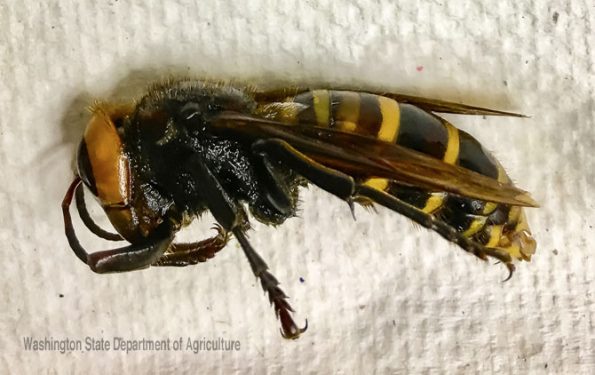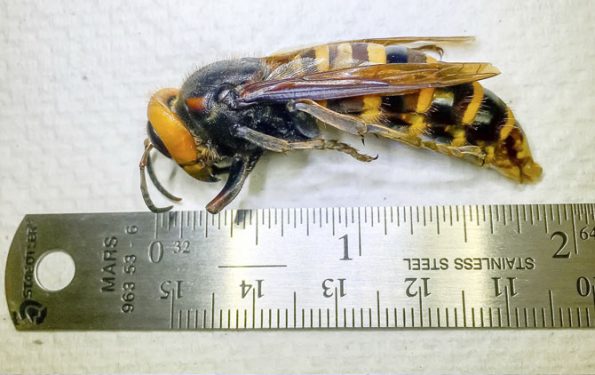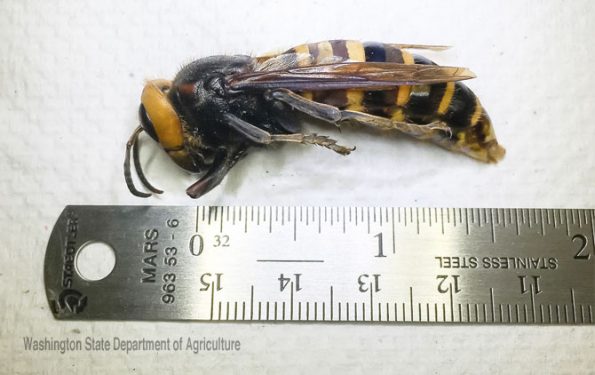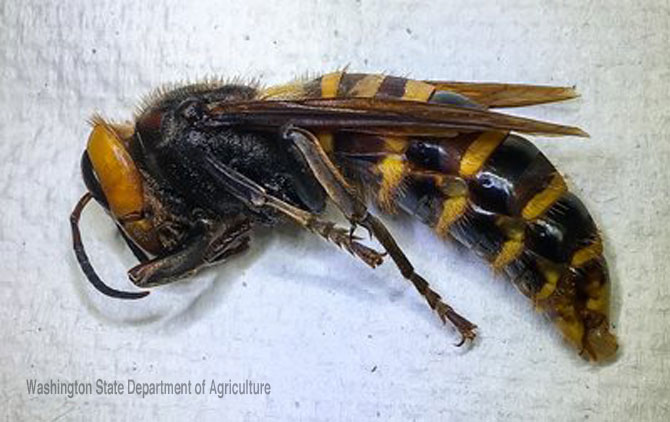
Washington Traps First Asian Giant Hornet – WSDA Virtual Press Conference (Friday July 31, 2020).
The Washington State Department of Agriculture (WSDA) announced on Friday July 31, 2020 the first confirmed discovery of a trapped Asian giant hornet (Vespa mandarinia) following a specimen discovery on July 14, 2020. The recently trapped Asian Giant Hornet specimen on July 14, 2020 indicates a nest is established in the State of Washington area. The specimen is about the size between a queen and a worker, but the classification was not initially confirmed. According to WSDA Managing Entomologist Sven-Erik Spichiger, the specimen was sent to the USDA “Systematic Entomologist Laboratory in Washington D.C.” where scientists will perform a dissection and analysis. Spichig said he thinks it is probably a queen because this is the time of year that workers are out foraging while queens are safe in nests.
The hornet was found in a WSDA trap set near Birch Bay in Whatcom County. WSDA trappers checked the bottle trap on July 14, 2020 and submitted the contents for processing at WSDA’s entomology lab. The hornet was identified during processing on July 29, 2020. The specimen was the first hornet to be detected in a trap, rather than found wild in the environment as the five previous confirmed official sightings occurred in the State of Washington beginning December 8, 2019.
“This is encouraging because it means we know that the traps work,” Sven-Erik Spichiger, managing entomologist for the department said. “But it also means we have work to do.” There is a rush work effort to discover and destroy the nest before nest produces queens that could spread to region to create more nest next Summer. Scientists hope to locate any Asian Giant Hornet nests by early to mid-September. Up to 200 queens can leave a nest.
WSDA’s next steps are to search for nests using infrared cameras and place additional traps in order to catch live Asian giant hornet specimens. WSDA Pest Program staff will deploy special traps intended to trap hornets but keep them alive. If they catch live hornets, the department will attempt to tag and track them back to their colony. Once located, the agency will eradicate the colony.
The first official Asian Giant Hornet discovery in North America was in mid-August 2019 in the Robins park area of south Nanaimo in British Columbia. The British Columbia Ministry of Agriculture confirmed the discovery and destruction of an entire nest, reporting that on the evening of Wednesday, September 18, 2019, an Asian giant hornet’s (Vespa mandarinia) nest was located in the ground in the Robin’s Park area in south Nanaimo and destroyed.
WSDA hopes to find and destroy any or all nests (which have not been discovered yet) by mid-September before the colony in each nest would begin creating new reproducing queens and drones. Until that time, the colony will only contain the queen and worker Asian giant hornets. Destroying the nest before new queens emerge and mate will prevent the spread of this invasive pest. Without the destruction of the nest, it is possible that several Asian Giant Hornet nests could be created during the Spring and Summer of 2021.
The term ‘Murder Hornet’ used by some media to re-name the Asian Giant Hornet is cringeworthy to most entomologists, who consider the Asian Giant Hornet a non-aggressive insect. However, over 40 people were killed in China and over 1500 injured from July to the end of the year in 2013. About 12-50 people are killed by Asian Giant Hornets each year in Japan. The hornets are aggressive and dangerous to humans who accidentally get too close to their nests. The Asian Giant Hornet’s venom isn’t necessarily more lethal than many other stinging insects, but the volume of venom per sting is greater because of the larger size of the hornet and stinger. Also the venom contains a peptide (mastoparan) or peptides that can cause destruction of tissue, especially when victims are stung multiple times. Victims in China in 2013 were shown with large bullet-hole size wounds (necrotic lesions) while they were hospitalized. The sting is reported to be extremely painful, like a searing hot nail.
A literature review study published in 2007 of people in Japan who suffered multiple organ failure from an Asian Giant Hornets attack reported that the mean number of stings in people who died from the attack was 59, while the mean number of stings was 28 in people with multiple organ failure who survived an attack. The scientists concluded that the presence of cutaneous hemorrhaging or necrosis after a hornet attack may indicate multiple organ injury.
Most Asian Giant Hornet human victims appear to die from anaphylaxis or sudden cardiac arrest, while some of them die from multiple organ failure including rhabdomyolysis, renal failure, liver dysfunction, respiratory failure, and disseminated intravascular coagulopathy (DIC). The literature review noted three articles that described unusual complications including nephrosis (kidney disease), Bell’s palsy, and Guillanain-Barre syndrome (an autoimmune attack on nerves with a mortality of 4% to 7%).
The WSDA priority is to prevent Asian Giant Hornets from becoming established in their region. From an agricultural perspective, the major concern of the Asian Giant Hornet is the threat to honey bees. A small squad of Asian giant hornets can kill an entire honey bee hive in a matter of hours. The honey bee larvae are then transported by Asian Giant Hornets back to their own nest to feed their own larvae.
Unfortunately, Washington State particularly Western Washington is ideal habitat for Asian Giant Hornet … [from early modeling indications] everything basically east of the Mississippi River would be ideal habitats, and the Pacific Northwest including northern California, Oregon, and Washington also serves as excellent habitat for Asian Giant Hornet.
— Sven-Erik Spichiger, Managing Entomologist at Washington State Department of Agriculture (WSDA)
Experts are not sure how Asian Giant Hornets recently entered British Colombia and the State of Washington, but suspect a stowaway or illegal shipment of a nest. A package with an entire Vespa mandarinia nest containing live larvae and pupae was once intercepted at a U.S. port of entry, according to the Washington State Department of Agriculture — quoting a personal communication in 2020 with Allan Smith-Pardo, an entomologist – National Apoidea Specialist and biological scientist with the USDA-APHIS-PPQ Science and Technology. Initially details of the incident have not been released. Numerous cargo ships make their way into Pacific Northwest city ports.
Could Asian Giant Hornets be smuggled into Chicago’s O’Hare? The illegal smuggling of an Asian Giant Hornet nest into O’Hare is a possibility. A stowaway, fertilized Asian Giant Queen is also a possibility; however, not all fertilized queens are successful at establishing a new nest. Therefore, the creation of a nest in Chicagoland, for example near the Des Plaines River just east of O’Hare near Rosemont, would be possible, but not likely. Most fertilized queens don’t survive all the way to the next season to establish a successful nest.
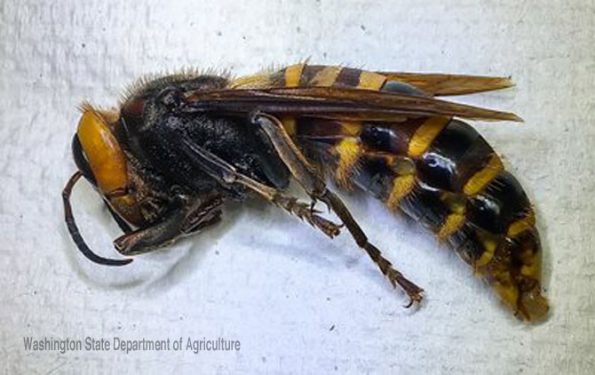
No incidents of official sightings of Asian Giant Hornets have been reported in Illinois, although an unofficial sighting was reported in 2012 in Arlington Heights. European Hornets or Vespa crabo, a species that is established in the eastern United States, including Illinois, have some resemblance to Asian Giant Hornets. Eastern Cicada Killer wasps and European Hornets are sometimes mistakenly suspected to be Asian Giant Hornets. Except for size, Eastern Cicada Killer wasps don’t resemble Asian Giant Hornets that closely. However, European Hornets and Asian Giant Hornet do look alike to the casual observer. The major quick distinguishing factor between Asian Giant Hornets and European Hornets are the stripes on the abdomen. The Asian Giant Hornet has solid dark rings on the abdomen. The European Hornet has narrower dark rings with a perpendicular “tear drop” marking. European Hornets are slightly smaller, but even European Hornets are impressively large. To date, no trapping programs are set up by the Illinois Department of Agriculture.
In addition to the traps that WSDA has set to catch Asian giant hornets, citizen scientist and other cooperators have placed over 1,300 traps. WSDA has told residents that those interested in trapping can still build and set traps on their own property. Traps require weekly bait replacement and a commitment to mail the trap contents to WSDA if bees or wasps are collected. If a citizen scientist traps a live Asian giant hornet, they should call the WSDA Pest Program hotline at 1-800-443-6684.
Because the number of Asian giant hornet workers increases as a colony develops, residents should be most likely to see an Asian giant hornet in August and September. If residents see an Asian Giant Hornet, they are instructed to report it at agr.wa.gov/hornets, and provide as much detail as possible regard regarding what was seen and where the hornet was seen. A photo is also desired if it can safely obtained. Specimens found dead are also wanted for potential testing.
Citizens can visit WSDA’s website at agr.wa.gov/hornets to learn more about Asian giant hornets. You can also submit questions the WSDA Pest Program at [email protected] or 1-800-443-6684.
We've trapped out first #AsianGiantHornet. You can watch the recorded press conference at https://youtu.be/JZHUMVfgXwk
Posted by Washington State Department of Agriculture on Friday, July 31, 2020
RESOURCES:
Yanagawa Y, Morita K, Sugiura T, Okada Y. Cutaneous hemorrhage or necrosis findings after Vespa mandarinia (wasp) stings may predict the occurrence of multiple organ injury: a case report and review of literature. Clin Toxicol (Phila). 2007;45(7):803-807. doi:10.1080/15563650701664871
Chen X, Zhang L, Wu Y, et al. Evaluation of the bioactivity of a mastoparan peptide from wasp venom and of its analogues designed through targeted engineering. Int J Biol Sci. 2018;14(6):599-607. Published 2018 Apr 25. doi:10.7150/ijbs.23419
RELATED NEWS …
Get updates from The Cardinal ALL NEWS FEEDS on Facebook. Just ‘LIKE’ the ‘Arlington Cardinal Page (become a fan of our page). The updates cover all posts and sub-category posts from The Cardinal — Arlingtoncardinal.com. You can also limit feeds to specific categories. See all of The Cardinal Facebook fan pages at Arlingtoncardinal.com/about/facebook …
Help fund The Cardinal Arlingtoncardinal.com/sponsor
